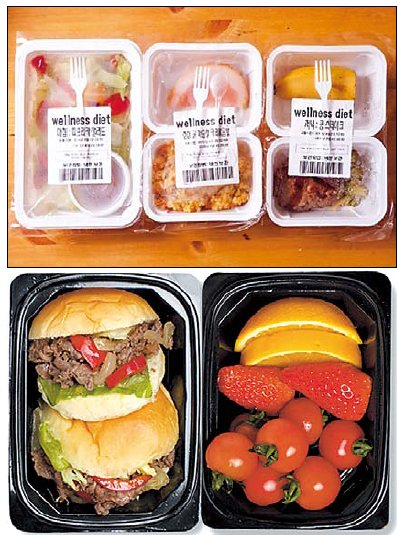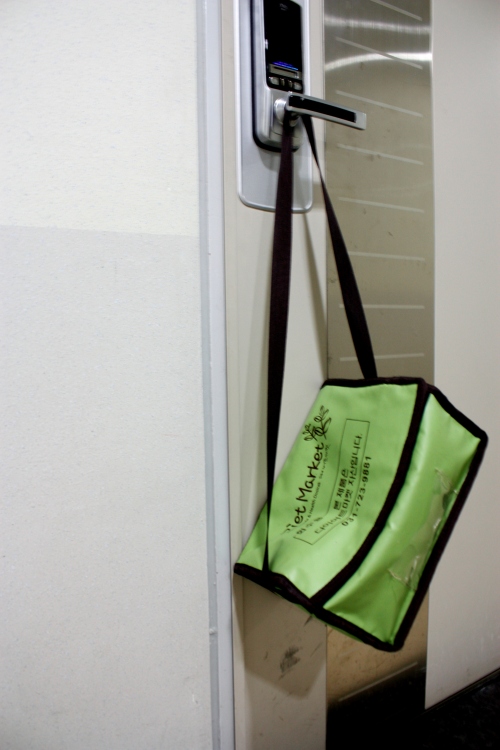
Meal boxes delivered to your door another diet trend for healthy eaters
Seoul arguably is the best place for anyone who either can’t or won’t cook.
Almost any food of any kind can be delivered right to your door, from 9 a.m. to 5 a.m. the next day. Fried chicken and cans of beer are the classic late-night snack to order in, while Chinese ― “jajangmyeon” (black soybean noodles) and “tangsuyuk” (sweet and sour pork) ― has always been popular among other delivery foods in Korea.
Yet it’s also hard to avoid the mouthful taste of MSG as you slurp down your “doenjangjjigae” (bean paste stew), and greasy chicken at 3 a.m. can be hard to stomach.
But “healthy, low-calorie” lunch boxes are a recent addition to Korea’s robust food delivery industry, targeting busy Seoulites who want to lose weight, or simply avoid processed foods.
AM Food, a hand-delivered lunch box business that opened in 2009, had sales of some 2 billion won ($1.8 million) this year, approximately three times more than two years ago. Its CEO, Kim Sang-wook, had been involved with the delivery food industry before founding the company.
“Most of the customers are in their 20s and 30s, who are working full time,” said Jang Won-young, the company’s marketing director.
“Our products are popular among many young, working married couples, particularly the ones who live in southern Seoul. We think the popularity of the delivered box meals came as more people are unable to make time for breakfast in the early mornings, as they are too busy with work.
“The key for this business actually lies in the delivery service. It takes many employees and an efficient organization.”
Diet Market, another popular delivered lunch box company founded this year by singer Kim Yong-jun, has been selling up to 200 million-300 million won worth of prepared meals per month. Focusing on healthy options, their boxes are low in calories and fat, as well as salt.
“Aside from those who are concerned about weight, many of our customers are pregnant women or diabetic,” said a PR officer of the company. “We use local veggies, Australian beef and Norwegian salmon after a careful process evaluating the quality of the ingredients.”
As a working Seoulite without much culinary passion, I decided to try these lunch boxes for a week. Eating two a day plus a regular lunch.
Seoul arguably is the best place for anyone who either can’t or won’t cook.
Almost any food of any kind can be delivered right to your door, from 9 a.m. to 5 a.m. the next day. Fried chicken and cans of beer are the classic late-night snack to order in, while Chinese ― “jajangmyeon” (black soybean noodles) and “tangsuyuk” (sweet and sour pork) ― has always been popular among other delivery foods in Korea.
Yet it’s also hard to avoid the mouthful taste of MSG as you slurp down your “doenjangjjigae” (bean paste stew), and greasy chicken at 3 a.m. can be hard to stomach.
But “healthy, low-calorie” lunch boxes are a recent addition to Korea’s robust food delivery industry, targeting busy Seoulites who want to lose weight, or simply avoid processed foods.
AM Food, a hand-delivered lunch box business that opened in 2009, had sales of some 2 billion won ($1.8 million) this year, approximately three times more than two years ago. Its CEO, Kim Sang-wook, had been involved with the delivery food industry before founding the company.
“Most of the customers are in their 20s and 30s, who are working full time,” said Jang Won-young, the company’s marketing director.
“Our products are popular among many young, working married couples, particularly the ones who live in southern Seoul. We think the popularity of the delivered box meals came as more people are unable to make time for breakfast in the early mornings, as they are too busy with work.
“The key for this business actually lies in the delivery service. It takes many employees and an efficient organization.”
Diet Market, another popular delivered lunch box company founded this year by singer Kim Yong-jun, has been selling up to 200 million-300 million won worth of prepared meals per month. Focusing on healthy options, their boxes are low in calories and fat, as well as salt.
“Aside from those who are concerned about weight, many of our customers are pregnant women or diabetic,” said a PR officer of the company. “We use local veggies, Australian beef and Norwegian salmon after a careful process evaluating the quality of the ingredients.”
As a working Seoulite without much culinary passion, I decided to try these lunch boxes for a week. Eating two a day plus a regular lunch.

For reference, I usually eat out, prefer sleeping over eating, and have been told I need to gain both muscle and weight. I rarely enjoy snacks, not a big meat-eater, and consume a lot of flour. I hate going to the gym, always have, and haven’t exercised in years.
Each box meal I tried contained 250 to 300 calories. Most home-cooked meals in Korea contain 700 to 800 calories, according to Diet Market.
Day 1
I woke up to find a text saying my lunch box had been delivered ― at 2 a.m. I found a green water-proof bag hanging from the doorknob. Inside were two lunch boxes, kept cool by a small bag of ice.
I started with a box containing a salmon wrap, which was a disappointment. Aside from the wraps, there was green salad, tofu, and black olives. I didn’t have much appetite to begin with, and found most of the food extremely bland. I barely finished.
The second box, which I had for dinner, was a pleasant experience. The club sandwich was filling, and the fresh raspberry shake was surprisingly delicious. There were also pieces of pineapple and Korean persimmon, complimented with lots of chopped almonds and pistachios. I felt great for eating “healthy.”
Day 2
I started the day with another healthy breakfast: a tuna salad, a huge piece of steamed pumpkin and fruit. I wasn’t happy with the salad dressing, finding it too bland and sour. Again, nothing was seasoned enough, so I had to get salt from the kitchen to eat the steamed egg the box provided.
The dinner box had two fajitas made of veggies and chicken breasts, bean salad and a piece of orange. I only ate one of the fajitas, as they were too bland, and finished the orange and the salad. It wasn’t particularly tasty, and I felt guilty for craving salt.
Days 3 & 4
No box was delivered because it was the weekend. I missed the boxes on Saturday morning, after sleeping in and finding myself too hungry to cook. I ended up going out for lunch with a friend, and had a tuna sandwich and potato soup. It certainly had more taste than the box meals, and I felt too full after finishing it all.
Throughout the weekend I ate whatever I wanted, including brownies, sundried tomato pasta and noodle soup. I constantly felt like I was eating much more than I was supposed to be, as I got full a lot faster than I did with the lunch box meals.
Day 5
Cold shabu-shabu! This was my favorite box meal so far. There were about five pieces of thinly sliced meat, along with a cup of cold dipping soup. It came with a piece of orange, steamed mushrooms, and five mini tomatoes. I felt strangely alert and awake after the meal, and skipped my coffee.
The dinner box was a steak made of tofu and tuna, which I did not like at all. But I found myself liking the bland salad dressing, and tried the eggs without salt. At midnight, however, I had an intense craving for spicy instant noodles.

Day 6 & 7
The featured menus included Vietnamese salad rolls, mushroom salad, tomato tuna salad and onigiri made with chicken breasts. For the last two days I tried to eat the meals without extra salt, and found myself not too bothered by it.
After finishing my last box, I weighed myself. I had lost no weight at all..
For most boxes, I enjoyed the side dishes and desserts more than the main meal. My favorites were steamed yam, pumpkins and potatoes, as well as fresh fruit including kiwis and pineapples. Would I ever order these boxes in future? Yes. But perhaps only for breakfast, without the bland salad.
** Where to order:
Diet Market: Diet Market offers a variety of diet dishes created by chefs who specialize in creating low-calorie, healthy menus. See the above for its specialties. Delivery is available in Seoul and some areas of Gyeonggi Province only.
Price ranges from 150,000 won to 675,000 won depending on 2-week or 4-week plans. For more information, visit www.dietdosirak.com or call (031) 723-9881.
Wellness Diet: If you are seriously concerned about your weight problems, consider Wellness Diet. Aside from its delivered lunch boxes, every customer gets a phone-consulting service and are offered a personalized schedule for meals and workouts. The breakfast menu mostly consists of bread and fresh fruits, with fried rice for lunch and green salad for dinner.
The amount of food you receive will be decided based on your weight and lifestyle. Delivery is available in Seoul and some areas of Gyeonggi Province only. For more information, visit www.wellness-diet.co.kr or call (070) 7868-7778.
AM Food: An ideal choice for those who prefer Western-style finger foods for their meals, especially for breakfast. The place offers three different menus: Finger Food Menu, Diet Menu, and Black Rice Menu.
The Finger Food Menu includes a petite-sized crab cheese strawberry vitamin wrap, and a ham curry garlic croissant sandwich, and Japanese-style tuna rolls. The Diet Menu mostly consist of chicken breasts and green salad. It also offers Asian-style meals on its Black Rice Menu, featuring huekmibap, nutritious black rice, along with curry, Chinese-style mapo tofu, and even Korean barbecue.
An English menu is available for the Finger Food Menu on the website. Prices range from 120,000 won to 324,000 won per month. Delivery is available in Seoul and Bundang, Gyeonggi Province only.
For more information, visit www.amfood.co.kr or call 1688-7473.
By Claire Lee (dyc@heraldcorp.com)
-
Articles by Korea Herald







![[Graphic News] More Koreans say they plan long-distance trips this year](http://res.heraldm.com/phpwas/restmb_idxmake.php?idx=644&simg=/content/image/2024/04/17/20240417050828_0.gif&u=)
![[KH Explains] Hyundai's full hybrid edge to pay off amid slow transition to pure EVs](http://res.heraldm.com/phpwas/restmb_idxmake.php?idx=644&simg=/content/image/2024/04/18/20240418050645_0.jpg&u=20240419100350)






![[From the Scene] Monks, Buddhists hail return of remains of Buddhas](http://res.heraldm.com/phpwas/restmb_idxmake.php?idx=652&simg=/content/image/2024/04/19/20240419050617_0.jpg&u=20240419175937)

![[KH Explains] Hyundai's full hybrid edge to pay off amid slow transition to pure EVs](http://res.heraldm.com/phpwas/restmb_idxmake.php?idx=652&simg=/content/image/2024/04/18/20240418050645_0.jpg&u=20240419100350)

![[Today’s K-pop] Illit drops debut single remix](http://res.heraldm.com/phpwas/restmb_idxmake.php?idx=642&simg=/content/image/2024/04/19/20240419050612_0.jpg&u=)